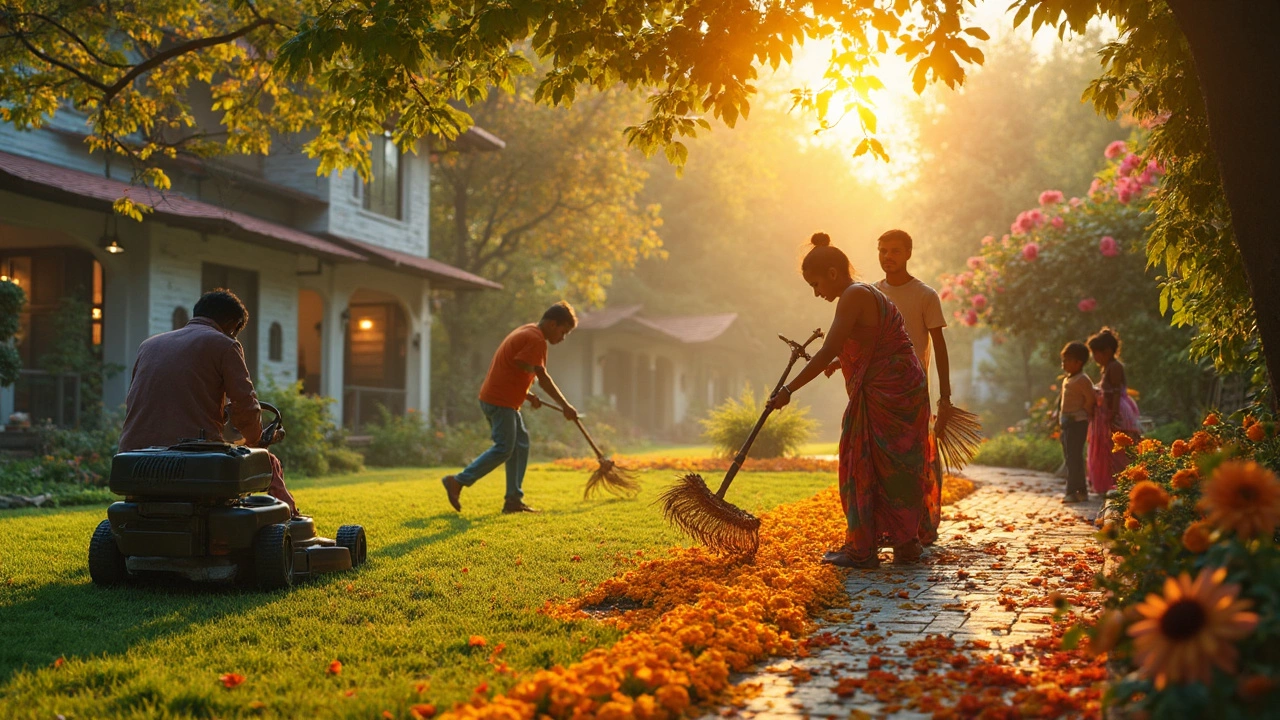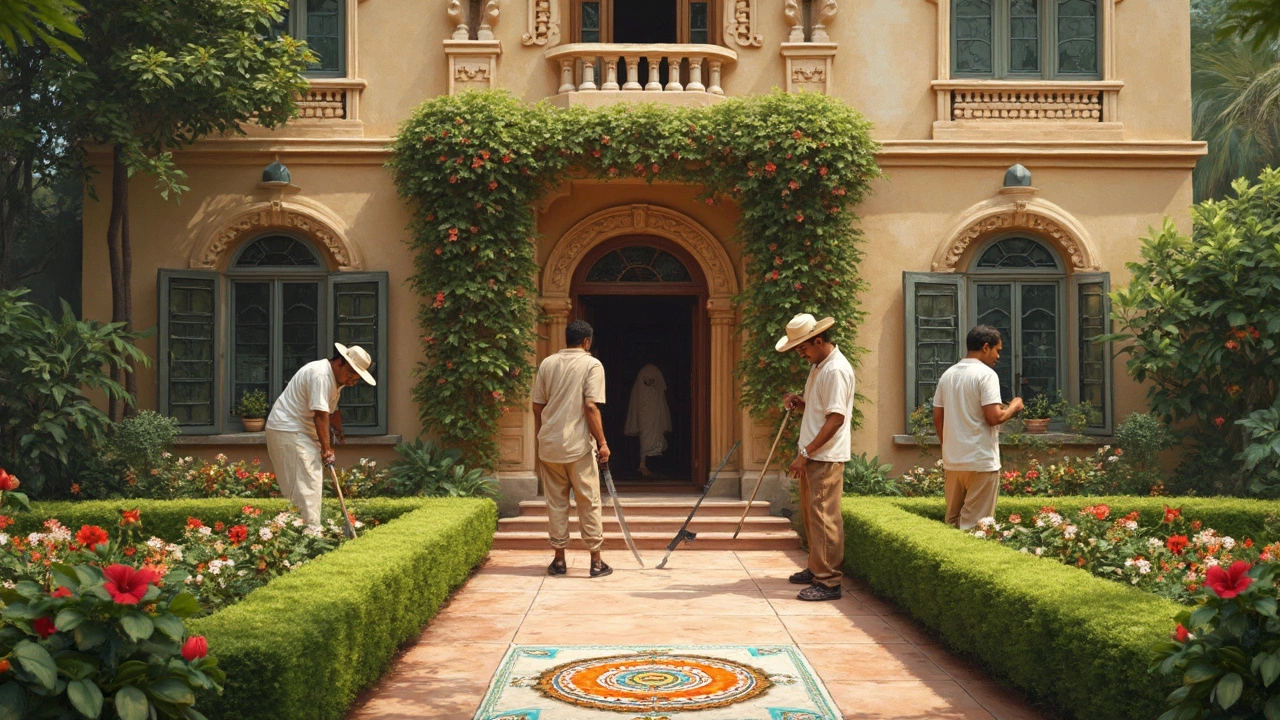Yard Work Basics: What Does Yard Work Include?

Most people think yard work means just mowing the grass, but there’s way more to it than that. Start with the basics—cutting the lawn, sure, but also edging where the grass meets the driveway or sidewalk. That sharp border makes your place look cared for, even if you skipped watering last week.
Leaves are another battle, especially in fall when it seems like your trees are dropping them just to spite you. Raking pulls double duty: it keeps your yard looking clean and also prevents mold and patches of dead grass underneath. Don’t forget twigs and small branches. After a windy night, you’ll find more debris than you’d expect. Quick tip: use a leaf blower if you can—it saves hours.
- Lawn Care Must-Haves
- Tidying Up: Leaves, Debris, and Edges
- Garden and Plant Maintenance
- Extra Tasks: The Stuff You Don’t Always Think About
Lawn Care Must-Haves
If you want a yard that looks good and makes your neighbors jealous (or at least stops them from complaining), focus on the basics. First up: regular mowing. Most cool-season grasses do best when you cut them to about three inches tall, and mowing weekly during peak growth keeps things neat. Dull mower blades tear grass, making it turn brown and get sick more easily, so sharpen those blades once or twice a season.
Watering comes next. Lawns usually need about an inch of water per week, either from rain or your hose. Early morning is the best time to water—it lets grass dry out during the day and keeps diseases away. Skip the evening watering unless you want to invite fungus to the party.
Don’t cheap out on fertilizing. A slow-release fertilizer 2-4 times a year gives grass what it needs without burning it. If your yard gets a lot of sun and action, you might need to feed it more. And watch out for weeds—crabgrass loves any empty spot it can find. Use a pre-emergent weed killer in early spring as a line of defense, and pull up the stragglers before they go to seed.
- Mow weekly (more in summer, less in winter)
- Keep mower blades sharp
- Water deeply once a week, not a quick daily sprinkle
- Fertilize with slow-release, not quick-boost stuff
- Tackle weeds before they spread
Edging is another simple trick that makes your yard look “done.” Use a string trimmer or manual edger along the driveway, walkways, and garden beds. Even if you skip weeding for a week, a clean edge hides a lot of sins. So when it comes to yard work, these basics can make a huge difference without you needing to spend all Saturday outside.
Tidying Up: Leaves, Debris, and Edges
When it comes to yard work, cleaning up leaves and debris is never ending. In the fall, a medium-size tree can drop anywhere from 30,000 to 50,000 leaves. If you let them pile up, they block sunlight and trap moisture, which can basically choke your lawn. Wet, soggy leaf piles attract pests, and mold isn’t just nasty—it can make your yard smell weird too.
Don’t stop at leaves. Twigs, acorns, pine cones, and random junk blow in or show up out of nowhere. Trash and debris not only mess with your lawn’s look, but they also chew up lawn mower blades. Stay ahead with regular sweeps; you don’t need to do a deep clean every week, but some quick pickup saves you bigger headaches later.
- Rake in straight lines for faster pickup and fewer missed spots.
- Mulch dry leaves instead of bagging them—most mowers can shred them right into the lawn, feeding your grass as they break down.
- Keep an eye out for pet waste; it’s not just gross, it can damage your grass if left there.
- Use a leaf blower on hard surfaces and tight spots, but don’t blast leaves into the street—it just makes it your neighbor’s problem.
Let’s not forget about edging. Clean edges where the lawn meets sidewalks or driveways make the whole yard look sharp. Most people skip this step, but it’s honestly the secret sauce to that polished, pro look. Edging tools or even a simple string trimmer can do the job, cutting away grass that wants to creep where it doesn’t belong. Do this every couple weeks to avoid monster overgrowth.
Together, these tasks might sound like busywork, but they make a big difference. Not only does tidying up keep your home looking tidy, it literally helps your yard work pay off—with fewer bugs, less damage, and a space you’re not embarrassed for people to see.

Garden and Plant Maintenance
Keeping flowers, shrubs, and trees healthy is a big chunk of what yard work is really about. You can’t just plant stuff and walk away—plants need regular trims, weeding, and some attention with fertilizers. If you let weeds take over, they’ll choke out the plants you actually want, making all your earlier efforts pretty much useless. That’s why regular weeding is non-negotiable, no matter how tiny the flower bed.
Pruning and trimming sound boring but they keep plants strong and looking decent. Deadheading flowers (snipping off old blooms) helps new buds grow faster. For shrubs and small trees, a good trim prevents branches from turning into a tangled mess. If you’re not sure when to trim, spring and late fall are usually safe bets for most common garden plants.
Don’t forget about mulching. A two- or three-inch layer keeps the soil moist, fights weeds, and even keeps your beds neater after rain. Spare yourself watering headaches by giving your garden a deep soak once a week—but small pots and new plantings might need more.
Here’s a quick look at common garden chores and how often most people do them:
| Task | How Often |
|---|---|
| Weeding | Every 1-2 weeks |
| Pruning/Trimming | 1-2 times per season |
| Mulching | 1-2 times per year |
| Fertilizing | 1-4 times per year |
| Watering | Once a week (or as needed) |
If you want the most out of your yard work, pay attention to pest control in the garden too. Look for chewed leaves or bugs hiding under pots. Catching problems early is a lot easier than dealing with a garden full of holes and dead plants. And one big time-saver—group plants with similar needs together so you can water and care for them quickly.
Extra Tasks: The Stuff You Don’t Always Think About
This is the part where most people are caught off guard. Yard work isn’t just about grass and leaves—it’s the low-key jobs that make a big difference. Think about cleaning gutters, washing down patios, or even pressure washing siding to keep mildew and gunk at bay. The small details have a real impact on your whole yard’s look and health.
Sometimes you’ll need to handle pests, like ants that turn your lawn into a minefield or aphids munching on your plants. Simple traps or sprays for minor problems usually work, but if you see large patches of damage, it might be time for a pro. And don’t forget weed control. Did you know a typical American yard has an average of 1,250 weeds popping up each season? That’s according to a survey by the National Association of Landscape Professionals.
- Yard work also means tackling outdoor furniture—cleaning it, covering it for the winter, or even storing it away.
- Mulching flower beds keeps weeds down and soil moist. A 2 to 3-inch layer works best.
- Pruning big shrubs or small trees helps with airflow and prevents diseases, but you want to do it at the right time of year—usually late winter or early spring.
- Checking irrigation: Look for leaks or broken sprinklers. Even a tiny leak wastes hundreds of gallons over a season.
Ever had trouble with stormwater runoff? Keeping storm drains clear is part of yard work, too. Clogged drains can flood your yard or even the basement. Here’s a look at common extra yard tasks and how often they need attention:
| Task | How Often | Why It Matters |
|---|---|---|
| Clean gutters | Every fall & spring | Prevents water damage |
| Pressure wash hard surfaces | Once a year | Removes grime & algae |
| Mulch beds | Once a year | Stops weeds, conserves water |
| Check irrigation | Monthly in season | Saves water, avoids dead patches |
| Prune shrubs/trees | Once or twice a year | Keeps plants healthy |
| Storm drain check | After heavy storms | Prevents flooding |
Here’s a reminder from someone who knows what’s up.
“A healthy yard isn’t just mowed—it’s well-loved. The best yards get attention to the smallest details, from gutters to fences to flower beds.” — Mark Schmidt, Certified Arborist, Madison, WI
So when you’re thinking about yard work, remember: the secret sauce is in the tasks you may not even see—until they’re left undone.
